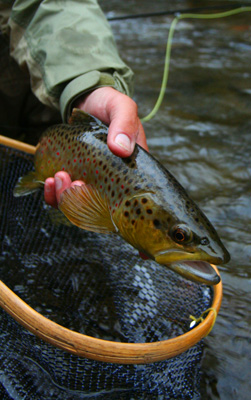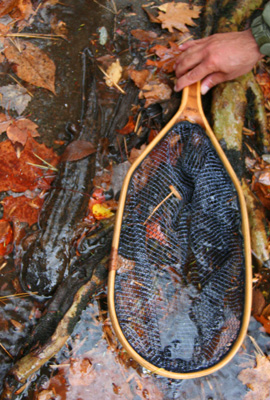We’ve had our usual slow down in guiding in mid-November. This has had us scrambling to get as much fishing in as possible while the weather is still pretty good. That may be up for debate as we’re looking at a week of weather that sure looks like it’s winter. Newfound Gap Road was closed yesterday due to snow and ice while the view of Thunderhead Mountain and Mount LeConte from our house confirms the high mountains are covered with snow. Daytime temperatures aren’t forecast to get out of the 40’s for more than a few hours in the coming week.
We’ve had some good fishing though. Charity and I spent a day fishing on Little River a few days back. We agreed that we would spend the day headhunting, moving from spot to spot and looking for big brown trout to cast at. Early November is a great time for this as post-spawn browns are extremely active and can be found feeding in the tails of pools or shallow riffles. This can be a tough program to stick with if you see plenty of other feeding fish, but we stayed true and didn’t fish as much as we looked and lurked about the stream.
This is an extremely slow method of fishing for anyone accustomed to constantly casting. We’ll spend far more time moving and looking than actually fishing. Often one of us has to watch from another vantage point and direct the angler since their view might not be clear because of glare. I caught this 16″ brown trout from the tail of a pool on Little River. The fish was moving about quite a bit in about 18″ of water so I changed from a big nymph to a #16 Pheasant Tail. The fly landed about two feet up and to the right of the fish and he ate it like a champ. Charity yelled down that he ate but I was already bringing the rod tight. This wasn’t the largest fish we cast to, but the only one we got a hook in.
Charity spotted this hellbender. She initially thought it was a brown trout wedged in a crack in the rocks, but quickly recognized it for what it was. Most folks are unaware of hellbenders and very few ever see one. I’ve often told anglers about them, but usually get skeptical looks in response. You can learn more about hellbenders here. I’ve included this like since I’m sure many think I’m pulling their leg. I get that all the time with fishing spiders too, but they’re real. Fact is stranger than fiction as my grandmother used to say.
Hellbenders are the largest species of salamander in the world and actually common in the Smokies. However, their camouflaged appearance, slow moving nature, and propensity for hiding in dark spots along streams make them hard to find.
The hoop on this net is 18″ long so you can tell the salamander is a little bigger than that. While this one was a pretty good one, they grow larger.


